|
 Secure Site
Secure Site
|
 |
Archive for the 'Zen Timepiece by Now & Zen' Category
 meditation in motion, walking mindfulness practice Attention, multitaskers: Want to exercise and meditate at the same time? Try Breathwalk, a form of walking meditation that incorporates pranayama and mantra techniques from the Kundalini Yoga tradition. The late Yogi Bhajan introduced this practice to the West in the early 1970s. Since then, yoga students of all shapes and sizes have used it to improve their cardiovascular health, tone their nervous system, boost their energy, stabilize their moods, quiet mental chatter, and embrace the present moment. In its full form, Breathwalk is a five-step process that can take up to 60 minutes; here’s an abbreviated routine you can do in less than 20. Try it in a meadow, on the beach, in the woods, or, if you’re feeling adventurous, on a city street.
The Practice
Begin walking at a normal pace, observing your bodily sensations. Then tune into your breath. Are you breathing with your chest muscles or with your diaphragm? Is your breath shallow and erratic or smooth and deep? Noisy or quiet? Through your mouth or through your nostrils? Gradually refine your breath so that it becomes nasal, diaphragmatic, and free of noise and irregularities.
Now coordinate your breath with your stride, inhaling for four steps and exhaling for four steps. When this feels comfortable and automatic, begin to practice the following breathing pattern: Keeping your nasal passages and facial muscles relaxed, take four short staccato puffs of air through the nostrils—one puff for each step. (Your breath will be audible now; focus on the sound.) Essentially, you are dividing your inhalation into four segments that are synchronized with four consecutive steps. After the first puff, your lungs should be about one-quarter full; after the second, two-quarters full; after the third, three-quarters full; and after the fourth, four-quarters full.
 zen stones Without pausing, exhale in the same fashion, contracting the abdominal muscles and pushing the navel to the spine for four steps (and four segments of the out-breath), so that the final puff pushes the last quarter of air out of your lungs. Continue this pattern for five minutes, then walk and breathe normally for three minutes. As Gurucharan Singh Khalsa, senior student of Yogi Bhajan and co-author of Breathwalk, says, “It’s not about, ‘How far did I walk, how many calories did I burn, how much effort was expended?’ It’s about synchronizing the body, breath, and mind to the present moment, about experiencing a profound sense of connection with yourself and nature.”
Now, repeat the eight-minute practice. This time, as you synchronize your segmented breath with your stride, mentally say the mantra sa ta na ma—one sound for each step and each segmented breath. Repeat the mantra in coordination with the quartered breath for five minutes, then walk and breathe normally for another three.
“Practice for three days in a row and you’ll feel the energizing, focusing effects immediately,” Khalsa says. “If you do it for 40 days you can get really intimate with the technique. You can slip it into the cracks of your day to support you—that’s its purpose.”
adapted from Yoga International, by Shannon Sexton
 Tibetan Meditation Timer with Brass Singing Bowl Now & Zen
1638 Pearl Street
Boulder, CO 80302
(800) 779-6383
Posted in Bamboo Chime Clocks, Meditation Timers, Meditation Tools, mindfulness practice, Now & Zen Alarm Clocks, Zen Timepiece by Now & Zen, Zen Timers
Kyoto meets Giverny in this artful garden, a sublime space for contemplation.
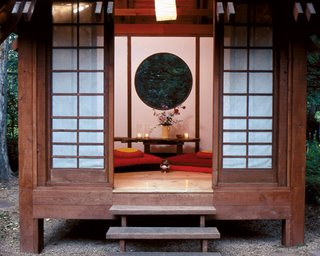 teahouse, photo by Povy Kendal Atchison Japanese shoji screens traditionally are made from translucent rice paper, but the owners chose a durable, light-penetrating fabric that will prevail in harsh weather. It allows filtered light without sacrificing privacy. The floor is salvaged pine planks from a park ranger’s mountain cabin, and a round window brings in the garden even when the doors are closed.
Ten years ago, a Boulder, Colorado, couple bought a house on a patch of grass with some overgrown shrubs, sliced by an irrigation ditch. Where many people might have seen desolation, these intrepid gardeners saw the opportunity to create a private world of solitude and renewal. In the process, they discovered that designing and planting is as soothing as enjoying the completed garden.
The contemplative garden they’ve created gently nods to Asian style while embracing European impressionism. It borrows from 19th-century impressionist painter Claude Monet, as well as from the Japanese love of plant textures, weeping trees and artfully placed rocks. It includes water, rocks, expanses of greenery and winding paths, but not the formal Japanese plantings that require so much upkeep.
Monet’s famous garden in Giverny, France, includes a Japanese bridge over a water lily pond. In this Colorado garden, a pale-aqua bridge arches over an irrigation ditch that’s been funneling water to farmers for 100 years. Just as the lily pad pond became the Monet garden’s major draw, the ditch has been transformed—lined with sandstone rocks alongside a bed of river rocks. Gold, yellow and orange daylilies drape the bank, blooming in midsummer when the Siberian and Japanese irises offer only seed pods. Ornamental grasses bend and sway to the breeze stirred up by the water’s flow. The ditch is an enticement; visitors brace against the railing and peer into the water, watching blossoms float downstream.
Every corner of this garden was designed with careful thought, not lavish funds. A decade of hard work and trial-and-error provided an education.
Piecing together elegance
Every corner of this garden was designed with careful thought, not lavish funds. A decade of hard work and trial-and-error provided an education. In hindsight, the homeowners believe their decision to tackle their garden in small pieces rather than taking on the entire half-acre saved them time, money and frustration.
“We didn’t have a grand master plan,” one of the homeowners admits. Instead, he started by clearing dead and dying trees. Then he parceled the property into smaller gardens: a ditch lined with water-loving plants and flagstones circles the edges of the gardens and is sprinkled with elfin thyme and other herbs for groundcover.
To imitate nature’s undulating, uneven landscape, he built mounds, or berms, from garden soil, adding interest to the flat piece of land. Berms also provide quick drainage for plants that might never take hold without humus and gravel. Sun-loving plants such as foxtail lilies and peonies are located on the sunny mounds. Shade-loving hostas line the flagstone walkways under giant locust trees.
“It all came together like a jigsaw puzzle,” the gardener says, with groundcovers of thyme and vinca, creeping veronica, wild strawberries and sweet woodruff. Groundcovers that can become invasive thugs, such as the sweet woodruff, were banished to the riverbank under the house, where it can duke it out with ornamental strawberries for space and light.
What’s in this garden?
• Crabapple trees (Malus spp), highly adaptable to most weather and soil conditions, have exquisite spring blooms. The weeping varieties include Red Jade, Coral Cascade, White Cascade and Louisa. Best to order from your local garden center.
• Species (or wild) tulips (Tulipa spp) have brilliant hues and hardiness. Long before more formal tulips became the backbone of Dutch gardens, miniature species tulips blanketed hillsides in Turkey. Most only can be grown in climates with winter temperatures. Order from trustworthy companies (see “Resources,” below) that propagate their own bulbs and do not harvest from the wild.
• Foxtail lilies (Eremurus spp) have attention-grabbing feathery spikes and day-glow colors. They’re easy to grow, but they do require good drainage to avoid root rot.
• Thyme (Thymus spp) may be slow to start, but once established, it tolerates some foot traffic. Best as filler between stepping stones, aromatic thymes will creep around rocks and steps, choking out weeds.
• Daylilies (Hemerocallis spp) have sweeping, grasslike foliage and arching blooms. Each blossom lasts only one day, but the plant blooms nonstop throughout summer. They require little care aside from division every few years, and only a moderate amount of water.
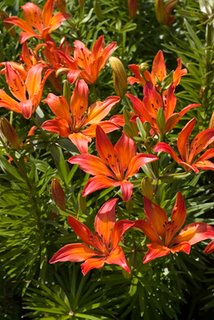 daylilies • Irises (Iris spp) are easy to grow if you choose the right cultivars for your garden. Siberian and Japanese irises grow best in moist, slightly acid soil, perhaps on the banks of a pond or stream. For alkaline soil and aridity, choose bearded irises. And if you love variegated leaves of white and green, look into Iris pallida.
• Hostas (Funkia spp), with wide, variegated leaves, add to foliage interest rather than floral displays. Lords of the shade garden, hostas can be found in a variety of sizes, some with blue-tinged or gold coloration and heart-shape leaves. All need some moisture and dappled shade.
Four seasons of splendor
In this garden, bold plants such as peonies and foxtail lilies are the prima donnas—showy and extravagant with heavy blooms. Other beauties are far smaller and require a closer look. Brilliant red and yellow species tulips—more natural looking than their formal, hybrid cousins—pop up among drifts of thyme. Delphiniums and their smaller brethren, larkspur, join foxgloves for height and extravagant color. Oriental poppies and California poppies display papery petals, popping up in mounds and drifts.
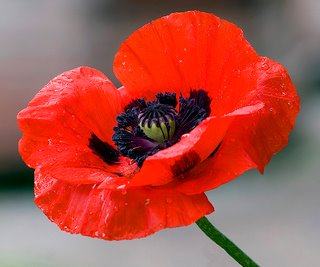 oriental poppy In early spring, the bright blues and purples of the groundcovers cluster throughout the garden, complementing the species tulips’ tiny blooms. By late spring, foxgloves and Siberian and Japanese irises dominate. Summer is golden, as daylilies offer orange, yellow and cream colors.
The garden may be at its best in winter, the gardeners claim. Japanese lanterns guide visitors down the flagstone footpath, and snow sets a black-and-white scene. Bare, weeping crabapple branches bend gracefully like sculpture. “Some of the most beautiful times in the garden are in the snow,” the homeowner says. “You see all the shapes that don’t go away: the mounds, rocks, ornaments, trellises.”
Reflecting in the teahouse
Autumn and winter usher in the garden’s quiet moments, when trowels are put away. A tiny teahouse, built of salvaged cedar siding left over after the house was built, holds sway. Once inside, a cup of hot tea banishes the cold. Sliding shoji screen doors open to the sparkling light on snow or close to keep out a brisk wind. The nine-by-nine-foot teahouse anchors this garden, a reminder that its primary purpose is to promote meditation and reflection rather than busyness. A Zen Timepiece adornes the interior so that one can timer their meditation practice. The naked branches of an old cottonwood tree loom over the teahouse while smaller pines and dwarf evergreens screen the street and neighborhood. “The teahouse gave us a focus for the garden,” the homeowner says, “and cut down the amount of lawn.”
In winter’s stillness, when birds are silent, only the bamboo wind chimes clink softly. The teahouse’s back wall features a round window that provides the most private views and connects the garden to the teahouse. “I wanted a big round window,” the owner says, “to bring the outside in.”
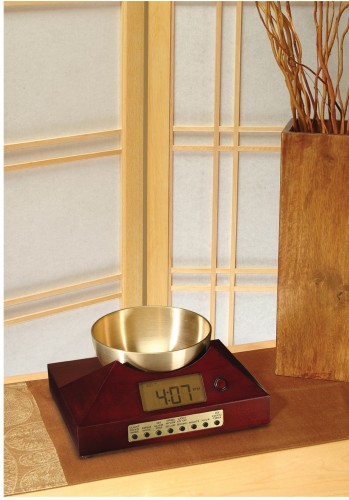 Zen Timepiece with brass singing bowl, a meditation timer. adapted from Natural Home Magazine, March/April 2008 by Niki Hayden
Now & Zen
1638 Pearl Street
Boulder, CO 80302
(800) 779-6383
Posted in Bamboo Chime Clocks, Chime Alarm Clocks, Japanese Inspired Zen Clocks, Now & Zen Alarm Clocks, teahouse, Well-being, Zen Timepiece by Now & Zen, Zen Timers
 yoga, loosen up pose Saturday: Loosen Up
The sun’s out and the day’s wide open. Savor your Saturday by twisting away any residual tension in your back. It’s a delicious way to wake up — or even wind down after running around town.
Supported Reclined Twist
What It Does
Helps the whole body (hips, spine, digestive system, nervous system, shoulders, chest, etc.) unwind. Promotes digestion and detoxification.
How to Do It
Set your Zen Yoga Timer to gong after 5 minutes. Lie on your back, dropping your left knee across your body to rest on a pillow or blanket. Shift your hips right to avoid over-twisting the lower back.
Rest your arms, elbows soft, on the floor over your head. Turn your head in whichever direction feels most comfortable and breathe into this gentle stretch for 5 minutes on each side, until the gong chimes.
adapted from Body + Soul, 2010
 Zen Yoga Timepiece in Maple Now & Zen
1638 Pearl Street
Boulder, CO 80302
(800) 779-6383
Posted in Chime Alarm Clocks, Japanese Inspired Zen Clocks, Well-being, Yoga Timer, Yoga Timers by Now & Zen, Zen Timepiece by Now & Zen, Zen Timers
 yoga, sooth frazzled nerves pose Friday: Soothe Frazzled Nerves
As another hectic workweek slows to a close, it’s time to downshift — and ramp up your self-care.
Friday’s pose quiets your mind and nervous system, restoring your inner resources so that you can fully enjoy the weekend ahead.
Supported Child’s Pose
What It Does
Releases the muscles in the back, gently opens the hips, boosts your energy.
How to Do It
Set your Zen Timepiece to gong after 5 minutes. Sit back on your heels with your legs folded under you and the tops of your feet on the floor. Open the knees wide and bend forward at the hips.
Rest your forehead (or your chest) on a pillow or blanket and keep your arms slightly bent. If your buttocks don’t reach your heels, place a blanket under your thighs. Relax and breathe deeply for 5 minutes, until your Zen Yoga Timer gongs.
adapted from Body + Soul, 2010
 Zen Timepiece with brass singing bowl, a yoga timer
Now & Zen
1638 Pearl Street
Boulder, CO 80302
(800) 779-6383
Posted in Bamboo Chime Clocks, Chime Alarm Clocks, Japanese Inspired Zen Clocks, Meditation Timers, Meditation Tools, Now & Zen Alarm Clocks, Well-being, Yoga Timer, Yoga Timers by Now & Zen, Zen Timepiece by Now & Zen, Zen Timers
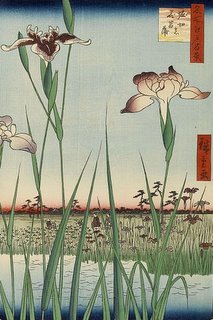 One Hundred Famous Views of Edo. #56. Irises at Horikirin, Hiroshige The term “Japanese iris” encompasses three varieties of irises cultivated in gardens or growing wild in Japan: hanashōbu, kakitsubata and ayame.
adapted from wikipedia.org
 Timer for meditation by Now & Zen Inc.
Now & Zen
1638 Pearl St.
Boulder, CO 80302
Posted in Chime Alarm Clocks, Japanese Inspired Zen Clocks, Meditation Timers, Meditation Tools, Natural Awakening, Now & Zen Alarm Clocks, Yoga Timer, Zen Timepiece by Now & Zen, Zen Timers
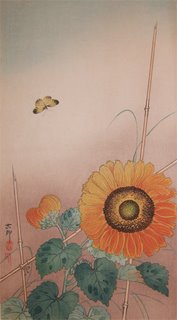 Koson, Small Butterfly And Sunflower - woodblock print Butterfly
sleeping
on the temple bell.
-Buson-
 Zen Timers and Bowl/Gong Alarm Clock, Temple Bell Alarm Clock
Now & Zen
1638 Pearl Street
Boulder, CO 80302
Posted in Japanese Poetry, Meditation Timers, Meditation Tools, mindfulness practice, Natural Awakening, Now & Zen Alarm Clocks, Progressive Awakening, Ukiyo-e, Well-being, Yoga Timer, Yoga Timers by Now & Zen, Zen Timepiece by Now & Zen
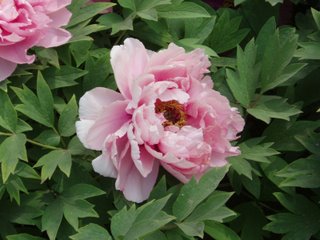 Paeonia Suffruticosa Peonies scattering,
two or three petals
lie on one another.
-buson-
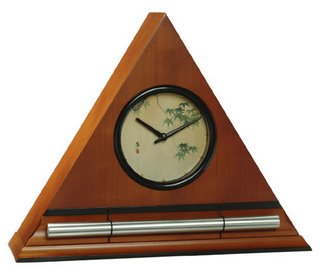 Zen Chime Clock with Maple Leaves in Honey Finish, progressive awakening clock
Now & Zen
1638 Pearl Street
Boulder, CO 80302
Posted in Bamboo Chime Clocks, Japanese Inspired Zen Clocks, Japanese Poetry, Meditation Timers, Meditation Tools, mindfulness practice, Natural Awakening, Now & Zen Alarm Clocks, Progressive Awakening, Yoga Timer, Zen Timepiece by Now & Zen
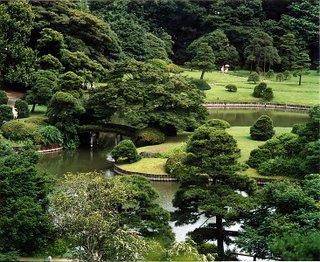 A kaiyu-shiki or strolling garden Chaniwa Gardens are built for holding tea ceremonies. There is usually a tea house where the ceremonies occur, and the styles of both the hut and garden are based on the simple concepts of the sado.
Usually, there are stepping stones leading to the tea house, stone lanterns, and stone basins (tsukubai) where guests purify themselves before a ceremony.
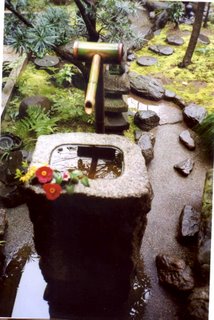 tsukubai Japanese gardens might also fall into one of these styles:
- Kanshoh-style gardens which are viewed from a residence.
- Pond gardens, for viewing from a boat.
- Strolling gardens (kaiyū-shiki), for viewing a sequence of effects from a path which circumnavigates the garden.
adapted from wikipedia.org
 Bamboo yoga and meditation timer
Now & Zen
1638 Pearl Street
Boulder, CO 80302
(800) 779-6383
Posted in Bamboo Chime Clocks, Japanese Inspired Zen Clocks, mindfulness practice, Natural Awakening, Now & Zen Alarm Clocks, Zen Timepiece by Now & Zen, Zen Timers
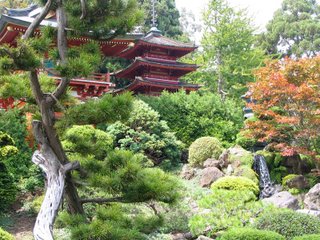 Hagiwara Japanese Tea Garden in San Francisco, California, showing the use of stone, water and plants Tsukiyama Gardens often copy famous landscapes from China or Japan, and they commonly strive to make a smaller garden appear more spacious.
This is accomplished by utilizing shrubs to block views of surrounding buildings, and the garden’s structure usually tries to make onlookers focus on nearby mountains in the distance. By doing this, it seems that the garden has the mountains as part of its grounds. Ponds, streams, hills, stones, trees, flowers, bridges, and paths are also used frequently in this style.
adapted from wikipedia.org
 Zen Timer for meditation by Now & Zen Inc.
Now & Zen
1638 Pearl Street
Boulder, CO 80302
(800) 779-6383
Posted in Beauty, Natural Awakening, Now & Zen Alarm Clocks, Progressive Awakening, Zen Gardens, Zen Timepiece by Now & Zen, Zen Timers
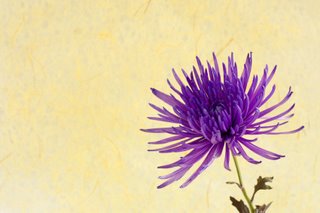 chrysanthemum Yellow or white dried chrysanthemum flowers are boiled to make a sweet drink in some parts of Asia. The resulting beverage is known simply as “chrysanthemum tea”.
Chrysanthemum tea has many medicinal uses, including an aid in recovery from influenza.
adapted from wikipedia.org
 Bamboo Zen Timers Now & Zen
1638 Pearl St.
Boulder, CO 80302
Posted in Chime Alarm Clocks, Japanese Inspired Zen Clocks, Zen Timepiece by Now & Zen
« Previous Page — « Previous Entries
Next Entries » — Next Page »
|
|
|
|